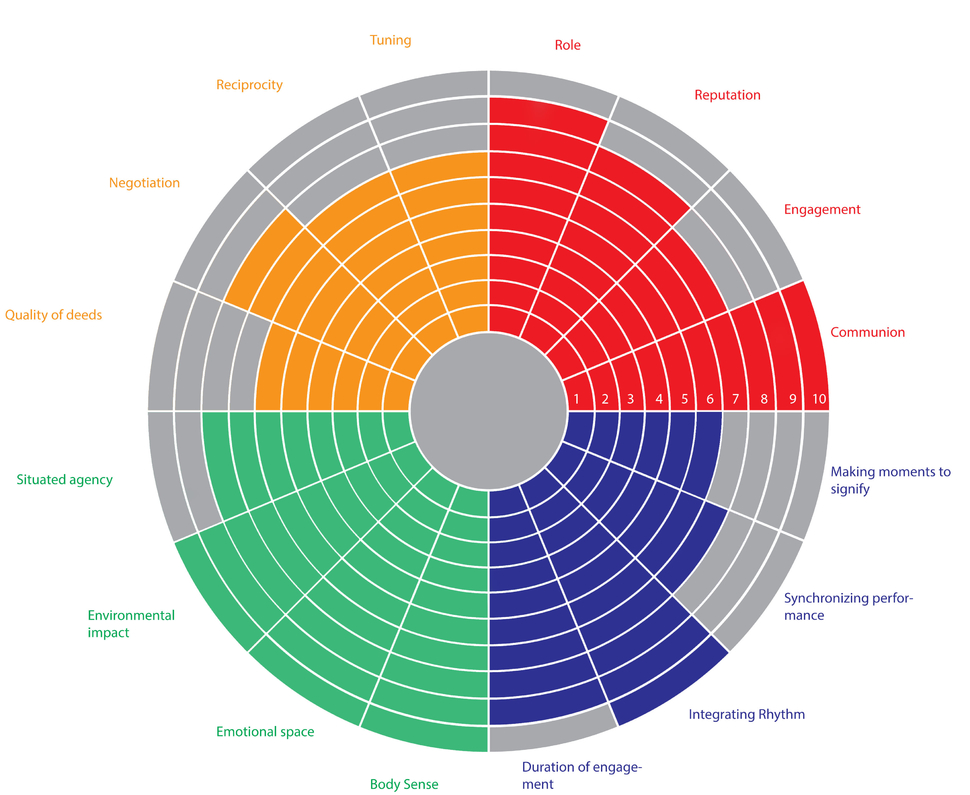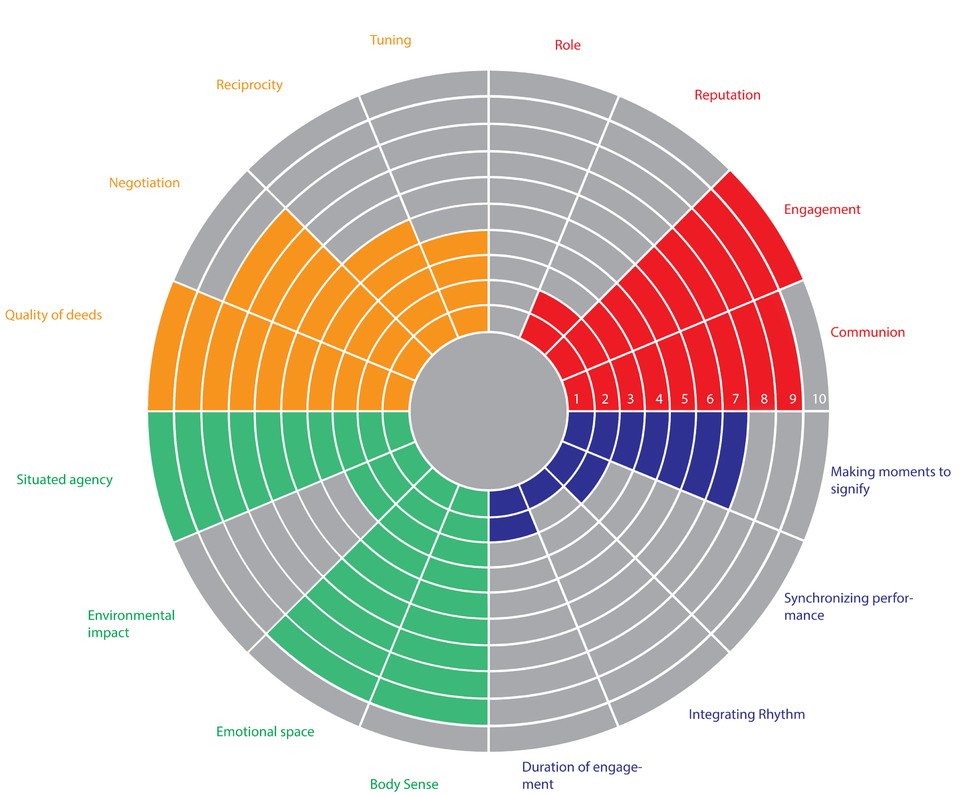Making a YUTPA analysis we considered the importance of all aspects for both tourists and texelaars in terms of our sub-system “Texel as host”. The YUTPA analysis shows with the values we gave the different sub systems how important the Texelaars/tourists find the specific topic. We did the analysis twice. Once for the tourists and once for the Texelaars. The analysis is devided into four parts: place, time, relation and action. These four parts are again devided into aspects. These aspects were given a number between 0 and 10, according to how important the specific aspect is to the concerned people. We specified that the value of 6 will represent the average importance of each aspect and then divided all our assumptions according to that scale.
Texelaar (Fig.1):
Place: We consider the ‘Place’ quarter to be of an extremely importance to the islanders, because this is the main factor that differs them from 'overkanters', a term they use for people from the other side of the Waddenzee.
Time: The time quarter has more variations between its four aspects. We think the duration of engagement is important for local people. They can be negative or positive about the duration of tourists’ stay on the island, but as long as it influences their daily life it will be of high importance. The same attitude can be applied to integrating rhythm and synchronizing performance aspects, because the less is influence on rythm of the daily life of local people the better. However, in terms of making moments to signify we assume that it is not of that much of importance, because for local people this is just daily life and this is as important as for any other person.
Relation: Aspects of these quarter we found to be more important than average in general, because we consider local people of Texel Island as a small community where everything is closely related, therefore communion field, role and reputation are of high importance.
Action: We think that this quarter depends a lot on the stage of the tourism on Texel Island according to the Butler’s lifecycle diagram and Doxey’s Irridex model. As it was stated before, we assume that the tourism on Texel Island is in the transition from the development stage to the consolidation stage. According to Butler and Doxey, this means that the attitude of residents towards tourists is more formal than friendly and is seen as a source of income. Therefore we consider “Action” quarter aspects to be of the average importance for local people.
Fig.1 YUTPA analysis-Texelaar
Tourists (Fig.2)
Place: The number per category shows the importance of the subject for tourists. One means that the subject is not important, and ten means that it is most important for the tourist. The first category is situated agency. This is about activities in relation to the island. Whether the tourists want to be active or not does not matter they come to enjoy the island, they want to be engaged with the island as much as possible. The second category is Environmental impact. Because the trips of the tourists only last on average around 3 nights it is likely that they care little about the impact they have, it is too short to see the impact, and as they are on holidays, they might not like to worry about it too much. Emotional Space is about the feeling of being on an island. Based on research done in 2013, 53 percent of the tourists gave the “island feeling” as a reason to visit Texel. You could say that this sense is very important for the visitor. The last category in the quarter of “place” is Body sense, this is about the way people feel. When people are on holidays they want to relax, enjoy and not worry. They want to have a good time and feel good. Body sense is very relevant for them.
Time: The second quarter in blue is about “time”. The first category is Duration of engagement. Duration of engagement in the area where you live is very long, on holidays this will always be shorter and especially on an island as Texel where every stay is around 3 nights. For tourists it is also not important to integrate rhythm. Tourists are not bound to appointments or other sorts of schemes. Most tourists will do what they feel like doing at a certain moment of the day. For them it is of no importance to integrate this rhythm with the islanders apart from boat departures and reservations in restaurants or hotels. In the same sense Synchronizing performance is of small importance because tourists do what they feel like doing and this is not necessarily synchronized with acts of the islanders. Making moments to signify means creating memories that are precious to you. Of course this is one of the goals of every tourist in the world. For the Texel tourist it might be a little bit less of importance because most of them are not going to see and experience something new but just to have the trusted feeling of peace, quietness, fresh air, coziness and ambiance.
Relation: The third quarter represents the main theme of “relation”. The category of communion is high rated because most people go with friends or family. The holidays are moments to be together and have a good time together. Engagement is about collaborating in activities, this is what visitors of the island do. Hiking, cycling, shopping, going to the beach, visiting Ecomare, Swimming, eating out, doing sports, visiting a museum and visiting the lighthouse are activities that most people engage in. Because visits are short-term reputation might be of less importance then back home. Because tourists know that they are rather anonymous and will leave in a few days. Being on holiday’s means that people are temporarily free from their jobs so at those moments it is of no big importance what your job or role is in everyday life.
Action: To finish there is the quarter of “action”. By Tuning we mean the way tourists act to other people. Tourists on Texel tend to be rather self-orientated, they don’t necessarily mean to meet new people. The island feeling is important for them so most likely a part of the tourists want to get engaged with the local Texelaars, but the main goals stay relaxing, enjoying nature and quietness. Reciprocity is “I give, you give”. Of course it works like that in terms of money, tourists give money in exchange for an experience. But it will not be about delivering an experience to the Texelaars, it is really orientated on their own experience. In that sense negotiation is of more importance as this is more related to money. Quality of deeds is a ten because people on holiday want their actions to give a positive feeling.
Fig.2 YUTPA analysis- Tourist
Tourists and Texelaars comparison.
For both the groups place is a main factor, it is why islanders are Texelaars and “overkanters” become tourists. The main difference is that Texelaars worry about the long term environmental impacts of their actions because it is about their home. Tourists feel not enough connection to the island to change their behaviour. This shows that the problem of the environmental pressure tourists put on the island is not only the matter of large number of people coming to the island, but also the fact that being sustainable while on the island is not important to them. If we heighten their awareness of the importance of the ecological footprint the tourism sector might become more environmentally friendly.
Time. For both sides the engagement with others will be short term because the average duration of stay is around 3 days. Integrating rhythm is for the islanders very important because their main source of income is tourism, it is important for them to plan their time so that it resonates with the rhythm of the tourists. The other way around, there is no reason for tourists to do the same. Creating memories is more important for tourists because that is their goal for that timespan, for the islanders this is of less importance because it is their everyday life.
Relations are important for the islanders; it is about their own neighbourhood, their reputation towards tourists determines the tourist’s view on the island. Because they are all Texelaars the feeling of communion is high. For the tourists their everyday role and reputation are not so important being on holidays, still the feeling of communion plays a big role being on holidays with your friends or family.
The quarter of action. The main difference is that both parties give something in return for something else, but it is mainly the case that tourists give money and the islanders give the opportunity of an experience in return. There is no equal relation of giving experiences. Another difference in this topic is the quality of deeds, this should be high for tourists but for the islanders it is just their everyday life and therefore quality of deeds is no main goal.

